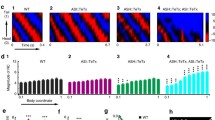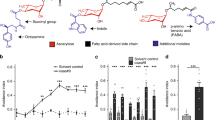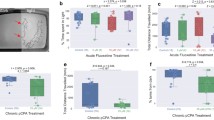Abstract
Serotonin plays an essential role in both the invertebrate and vertebrate nervous systems. ADF, an amphid neuron with dual ciliated sensory endings, is considered to be the only serotonergic sensory neuron in the hermaphroditic Caenorhabditis elegans. This neuron is known to be involved in a range of behaviors including pharyngeal pumping, dauer formation, sensory transduction, and memory. However, whether ADF neuron is directly activated by environmental cues and how it processes these information remains unknown. In this study, we found that ADF neuron responds reliably to noxious stimuli such as repulsive odors, copper, sodium dodecyl sulfonate (SDS), and mechanical perturbation. This response is mediated by cell-autonomous and non-cell autonomous mechanisms. Furthermore, we show that ADF can modulate avoidance behaviors by inhibiting ASH, an amphid neuron with single ciliated ending. This work greatly furthers our understanding of 5-HT’s contributions to sensory information perception, processing, and the resulting behavioral responses.




Similar content being viewed by others
References
Avery L, Bargmann CI, Horvitz HR (1993) The Caenorhabditis elegans unc-31 gene affects multiple nervous system-controlled functions. Genetics 134:455–464
Bargmann CI (2006) Chemosensation in C. Elegans. WormBook: the online review of C elegans biology:1–29. https://doi.org/10.1895/wormbook.1.123.1
Bargmann CI, Hartwieg E, Horvitz HR (1993) Odorant-selective genes and neurons mediate olfaction in C. elegans. Cell 74:515–527
Bargmann CI, Horvitz HR (1991) Chemosensory neurons with overlapping functions direct chemotaxis to multiple chemicals in C. elegans. Neuron 7:729–742
Bargmann CI, Thomas JH, Horvitz HR (1990) Chemosensory cell function in the behavior and development of Caenorhabditis elegans. Cold Spring Harb Symp Quant Biol 55:529–538
Brenner S (1974) The genetics of Caenorhabditis elegans. Genetics 77:71–94
Chang AJ, Chronis N, Karow DS, Marletta MA, Bargmann CI (2006) A distributed chemosensory circuit for oxygen preference in C. elegans. PLoS Biol 4:e274. https://doi.org/10.1371/journal.pbio.0040274
Chao MY, Komatsu H, Fukuto HS, Dionne HM, Hart AC (2004) Feeding status and serotonin rapidly and reversibly modulate a Caenorhabditis elegans chemosensory circuit. Proc Natl Acad Sci U S A 101:15512–15517. https://doi.org/10.1073/pnas.0403369101
Chase DL, Koelle MR (2007) Biogenic amine neurotransmitters in C. Elegans. WormBook : the online review of C elegans. biology:1–15. https://doi.org/10.1895/wormbook.1.132.1
Doroquez DB, Berciu C, Anderson JR, Sengupta P, Nicastro D (2014) A high-resolution morphological and ultrastructural map of anterior sensory cilia and glia in Caenorhabditis elegans. eLife 3:e01948. https://doi.org/10.7554/eLife.01948
Goodman MB (2006) Mechanosensation. WormBook: the online review of C elegans biology:1–14. https://doi.org/10.1895/wormbook.1.62.1
Guo M, Wu TH, Song YX, Ge MH, Su CM, Niu WP, Li LL, Xu ZJ, Ge CL, Al-Mhanawi MT, Wu SP, Wu ZX (2015) Reciprocal inhibition between sensory ASH and ASI neurons modulates nociception and avoidance in Caenorhabditis elegans. Nat Commun 6:5655. https://doi.org/10.1038/ncomms6655
Hilliard MA, Apicella AJ, Kerr R, Suzuki H, Bazzicalupo P, Schafer WR (2005) In vivo imaging of C. elegans ASH neurons: cellular response and adaptation to chemical repellents. EMBO J 24:63–72. https://doi.org/10.1038/sj.emboj.7600493
Hilliard MA, Bargmann CI, Bazzicalupo P (2002) C. elegans responds to chemical repellents by integrating sensory inputs from the head and the tail. Curr Biol: CB 12:730–734
Iwanir S, Brown AS, Nagy S, Najjar D, Kazakov A, Lee KS, Zaslaver A, Levine E, Biron D (2016) Serotonin promotes exploitation in complex environments by accelerating decision-making. BMC Biol 14:9. https://doi.org/10.1186/s12915-016-0232-y
Iwata R, Kiyonari H, Imai T (2017) Mechanosensory-based phase coding of odor identity in the olfactory bulb. Neuron 96:1139–1152 e1137. https://doi.org/10.1016/j.neuron.2017.11.008
Kang L, Gao J, Schafer WR, Xie Z, Xu XZ (2010) C. elegans TRP family protein TRP-4 is a pore-forming subunit of a native mechanotransduction channel. Neuron 67:381–391. https://doi.org/10.1016/j.neuron.2010.06.032
Kaplan JM, Horvitz HR (1993) A dual mechanosensory and chemosensory neuron in Caenorhabditis elegans. Proc Natl Acad Sci U S A 90:2227–2231
Kim K, Sato K, Shibuya M, Zeiger DM, Butcher RA, Ragains JR, Clardy J, Touhara K, Sengupta P (2009) Two chemoreceptors mediate developmental effects of dauer pheromone in C. elegans. Science 326:994–998. https://doi.org/10.1126/science.1176331
Li Y, Zhao Y, Huang X, Lin X, Guo Y, Wang D, Li C, Wang D (2013) Serotonin control of thermotaxis memory behavior in nematode Caenorhabditis elegans. PLoS One 8:e77779. https://doi.org/10.1371/journal.pone.0077779
Macosko EZ, Pokala N, Feinberg EH, Chalasani SH, Butcher RA, Clardy J, Bargmann CI (2009) A hub-and-spoke circuit drives pheromone attraction and social behaviour in C. elegans. Nature 458:1171–1175. https://doi.org/10.1038/nature07886
Pocock R, Hobert O (2010) Hypoxia activates a latent circuit for processing gustatory information in C. elegans. Nat Neurosci 13:610–614. https://doi.org/10.1038/nn.2537
Tobin DM, Madsen DM, Kahn-Kirby A, Peckol EL, Moulder G, Barstead R, Maricq AV, Bargmann CI (2002) Combinatorial expression of TRPV channel proteins defines their sensory functions and subcellular localization in C. elegans neurons. Neuron 35:307–318
Troemel ER, Chou JH, Dwyer ND, Colbert HA, Bargmann CI (1995) Divergent seven transmembrane receptors are candidate chemosensory receptors in C. elegans. Cell 83:207–218
Troemel ER, Kimmel BE, Bargmann CI (1997) Reprogramming chemotaxis responses: sensory neurons define olfactory preferences in C. elegans. Cell 91:161–169
White JG, Southgate E, Thomson JN, Brenner S (1986) The structure of the nervous system of the nematode Caenorhabditis elegans. Philos Trans R Soc Lond Ser B Biol Sci 314:1–340
Yang X, Wang S, Sheng Y, Zhang M, Zou W, Wu L, Kang L, Rizo J, Zhang R, Xu T, Ma C (2015) Syntaxin opening by the MUN domain underlies the function of Munc13 in synaptic-vesicle priming. Nat Struct Mol Biol 22:547–554. https://doi.org/10.1038/nsmb.3038
Yoshida K, Hirotsu T, Tagawa T, Oda S, Wakabayashi T, Iino Y, Ishihara T (2012) Odour concentration-dependent olfactory preference change in C. elegans. Nat Commun 3:739. https://doi.org/10.1038/ncomms1750
Yue X, Zhao J, Li X, Fan Y, Duan D, Zhang X, Zou W, Sheng Y, Zhang T, Yang Q, Luo J, Duan S, Xiao R, Kang L (2018) TMC proteins modulate egg laying and membrane excitability through a background leak conductance in C. elegans. Neuron 97:571–585 e575. https://doi.org/10.1016/j.neuron.2017.12.041
Zhang H, Yue X, Cheng H, Zhang X, Cai Y, Zou W, Huang G, Cheng L, Ye F, Kang L (2018) OSM-9 and an amiloride-sensitive channel, but not PKD-2, are involved in mechanosensation in C. elegans male ray neurons. Sci Rep 8:7192. https://doi.org/10.1038/s41598-018-25542-1
Zhou W, Wang J, Wang K, Huang B, Niu L, Li F, Cai F, Chen Y, Liu X, Zhang X, Cheng H, Kang L, Meng L, Zheng H (2017) Ultrasound neuro-modulation chip: activation of sensory neurons in Caenorhabditis elegans by surface acoustic waves. Lab Chip 17:1725–1731. https://doi.org/10.1039/c7lc00163k
Zou W, Cheng H, Li S, Yue X, Xue Y, Chen S, Kang L (2017) Polymodal responses in C. elegans phasmid neurons rely on multiple intracellular and intercellular signaling pathways. Sci Rep 7:42295. https://doi.org/10.1038/srep42295
Zubenko GS, Jones ML, Estevez AO, Hughes HB 3rd, Estevez M (2009) Identification of a CREB-dependent serotonergic pathway and neuronal circuit regulating foraging behavior in Caenorhabditis elegans: a useful model for mental disorders and their treatments? Am J Med Genet Part B Neuropsychiatr Genet 150B:12–23. https://doi.org/10.1002/ajmg.b.30891
Acknowledgments
We thank the Caenorhabditis Genetic Center for strains.
Funding
This work was supported by grants from Zhejiang Provincial Natural Science Funds of China (LR14C090001, to L.J.K.), the National Foundation of Natural Science of China (31771113, 31271180, 31471023, to L.J.K.; 31800878, to W.J.Z), the Fundamental Research Funds for the Central Universities of China (2017FZA7003, 2018FZA7004), the Major National Scientific Research Projects of the Ministry of Science and Technology of China (2013CB945603, to L.J.K.), and the National High-tech R&D Program of China (2015AA020512), and the Non-profit Central Research Institute Fund of Chinese Academy of Medical Sciences (2017PT31038, 2018PT31041).
Author information
Authors and Affiliations
Contributions
Jiajie Shao and Lijun Kang designed the experiments. Jiajie Shao, Xiaoyan Zhang, Hankui Cheng, Xiaomin Yue, and Wenjuan Zou conducted the experiments. Jiajie Shao, Wenjuan Zou, and Lijun Kang analyzed and interpreted the results. Jiajie Shao and Lijun Kang wrote the manuscript, and modification was provided by all the authors.
Corresponding authors
Ethics declarations
Conflict of interest
The authors declare that they have no competing interests.
Rights and permissions
About this article
Cite this article
Shao, J., Zhang, X., Cheng, H. et al. Serotonergic neuron ADF modulates avoidance behaviors by inhibiting sensory neurons in C. elegans. Pflugers Arch - Eur J Physiol 471, 357–363 (2019). https://doi.org/10.1007/s00424-018-2202-4
Received:
Accepted:
Published:
Issue Date:
DOI: https://doi.org/10.1007/s00424-018-2202-4




